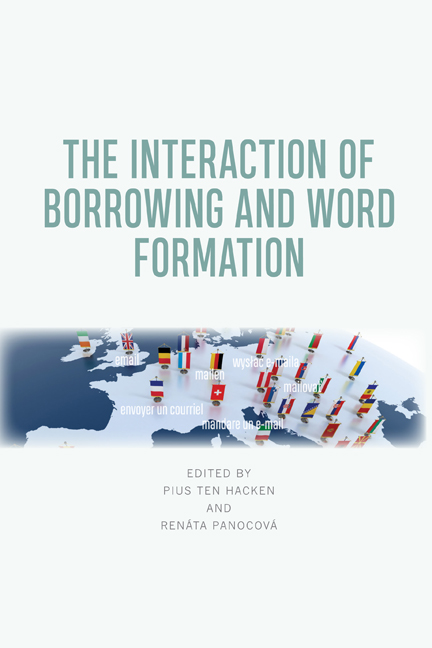Book contents
- Frontmatter
- Contents
- List of Figures and Tables
- List of Contributors
- Preface
- List of ISO-639 Language Codes
- Introduction
- 1 Word Formation, Borrowing and their Interaction
- Part I Compounding
- 2 Compounding and Contact
- 3 Neoclassical Compounds between Borrowing and Word Formation
- 4 Borrowed Compounds, Borrowed Compounding – Portuguese Data
- 5 Compound Calques in an Eighteenth-Century German-Lithuanian Dictionary
- 6 (Pseudo-)Anglicisms as Nominal Compounds in Italian
- Part II Affixation
- 7 The Role of Borrowing in the Derivation of Passive Potential Adjectives in Polish
- 8 How an ‘Italian’ Suffix Became Productive in Germanic Languages
- 9 The Suffixes -ismus and -ita in Nouns in Czech
- 10 The Interaction between Borrowing and Word Formation: Evidence from Modern Greek Prefixes
- Part III Naming in Minority Languages
- 11 Loanword Formation in Minority Languages: Lexical Strata in Titsch and Töitschu
- 12 Examining the Integration of Borrowed Nouns in Immigrant Speech: The Case of Canadian Greek
- 13 Interaction among Borrowing, Inflection and Word Formation in Polish Medieval Latin
- Conclusion
- 14 Trends in the Interaction between Borrowing and Word Formation
- Author Index
- Subject Index
6 - (Pseudo-)Anglicisms as Nominal Compounds in Italian
Published online by Cambridge University Press: 22 September 2020
- Frontmatter
- Contents
- List of Figures and Tables
- List of Contributors
- Preface
- List of ISO-639 Language Codes
- Introduction
- 1 Word Formation, Borrowing and their Interaction
- Part I Compounding
- 2 Compounding and Contact
- 3 Neoclassical Compounds between Borrowing and Word Formation
- 4 Borrowed Compounds, Borrowed Compounding – Portuguese Data
- 5 Compound Calques in an Eighteenth-Century German-Lithuanian Dictionary
- 6 (Pseudo-)Anglicisms as Nominal Compounds in Italian
- Part II Affixation
- 7 The Role of Borrowing in the Derivation of Passive Potential Adjectives in Polish
- 8 How an ‘Italian’ Suffix Became Productive in Germanic Languages
- 9 The Suffixes -ismus and -ita in Nouns in Czech
- 10 The Interaction between Borrowing and Word Formation: Evidence from Modern Greek Prefixes
- Part III Naming in Minority Languages
- 11 Loanword Formation in Minority Languages: Lexical Strata in Titsch and Töitschu
- 12 Examining the Integration of Borrowed Nouns in Immigrant Speech: The Case of Canadian Greek
- 13 Interaction among Borrowing, Inflection and Word Formation in Polish Medieval Latin
- Conclusion
- 14 Trends in the Interaction between Borrowing and Word Formation
- Author Index
- Subject Index
Summary
The occurrence of Anglicisms and pseudo-Anglicisms in Italian has steadily increased over the last few decades. The phenomenon is often referred to as the Anglicisation of the Italian language and appears to be moving Italian towards a new standard. The present study reports on a qualitative investigation into foreign patterns of word formation in contact-induced language change. My research question, therefore, is one about the convergence of word formation patterns across English and Italian (section 1): while English shows a strong preference for the right-hand head rule, Italian generally adheres to left-headedness in nominal compounding (section 2). Taking a broadly functional-cognitive perspective on the outcomes of contact with English right-headed word formation, the analysis discusses Italian classifying and identifying compounds primarily mediated through the press or coined for use as proper names (NPR) and trademarks (section 3). As will be seen, reductions to simplexes (section 4), loan translations, calques and Anglicisms (section 5), as well as second-generation neoclassical compounds, right-headed hybrid analogues and constructs with cognate bases that are formed in Italian (section 6) only ever have a reinforcing effect on word formation patterns that are already available to Italian, favouring their spread from learned to non-learned word formation.
(Pseudo-)Anglicisms in Italian
Over the last decades, a growing number of lexical borrowings from English have entered Italian. Whereas until the mid-twentieth century the core vocabulary of Italian numbered very few early Anglicisms (1a), borrowings since the 1950s (1b) and recent Anglicisms (1c) now count among the highly – or most – frequent words in the Italian core vocabulary (NVdB 2016).
(1) a. baby (1877), bar (1892), sport (1829)
b. design (1954), gay (1959), pop (1964), show (1954)
c. email (1991), internet (1997), post (1996), web (1996)
Together with the incremental increase in pseudo-Anglicisms (i.e. forms that depart from the English source form but ‘sound English’ to non-native Italian users, e.g. IT autogrill, N ‘motorway service area’, 1963 < IT Autogrill®, NPR), they are a sign of high Anglicisation (McArthur 2002) and appear to be moving Italian towards a new standard (Bombi 2017).
- Type
- Chapter
- Information
- The Interaction of Borrowing and Word Formation , pp. 86 - 110Publisher: Edinburgh University PressPrint publication year: 2020



